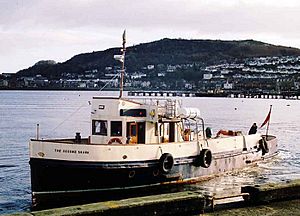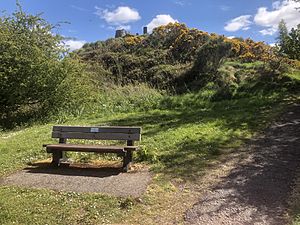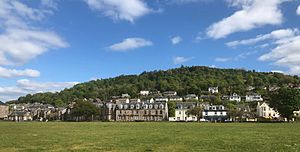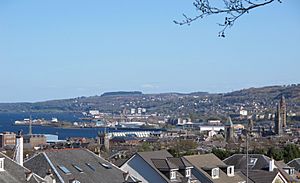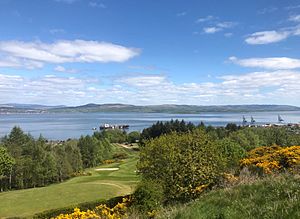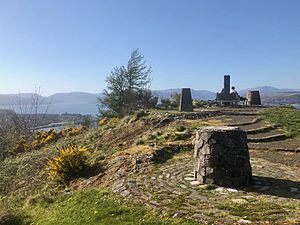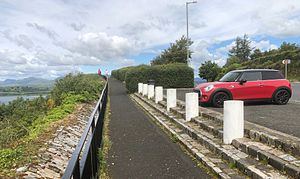Lyle Hill facts for kids
Lyle Hill is a famous spot in Greenock, Scotland. It's known for its amazing views! You can reach these viewpoints from Lyle Road, which was built a long time ago, between 1879 and 1880. The road was named after Abram Lyle, who was a very important person in Greenock and a well-known sugar refiner.
The highest point of Lyle Hill is called Craigs Top, which is about 130 meters (426 feet) above sea level. Before Lyle Road was built, the hill was known by other names like the Craigs or the Bingens.
From the viewpoints along Lyle Road, you can see across Gourock and the Firth of Clyde towards Cowal in the west. You can also look north over the Fort Matilda area of Greenock to Argyll across the Clyde. There are benches to sit on, information points to learn more, and a special beacon that is lit up for important events.
You'll find car parking spaces with great views. A little further down the road, there's the Free French Memorial. This memorial is shaped like the Cross of Lorraine combined with an anchor. It honors the Free French forces who fought in World War II. Across the road from the memorial, you can take steps and a path up to another viewpoint at Craigs Top, where you can see all the way up the River Clyde towards Glasgow.
Contents
The Hill's Old Names and History
Lyle Hill has had many names over the years! People used to call it the Craigs or Craigs Top, and also the Bingens, Mount Binian, or Binnan's Hill. These names might have come from the Gaelic word Binneans, which means "little hills."
Old maps from the 1800s show "Craigs Top" and "Craigs Farm House" in the area. Even older maps from the navy, called Admiralty charts, showed it as "Binian Peak" or "Mt. Binian" before eventually calling it Craigs Top.
In 1860, a guide book described Binnan's Hill as having a "precipitous crest" (meaning a steep, sharp top) and offering a "fine view of the Clyde from Dumbarton to Dunoon."
Building Lyle Road
In the late 1870s, Greenock was facing a lot of unemployment. To help people find work, the town decided to build a new road or carriage drive up to the Craigs. This road would start from the west end of Finnart Street.
In January 1879, it was decided to name the new road Lyle Road, after Abram Lyle. At that time, he was the town's Provost, which is like a mayor. Abram Lyle had a sugar refining business in Greenock. Between 250 and 400 men and boys worked on building the road.
The road was finished and officially opened on May 1, 1880. It stretched westwards down to the old toll gate for Gourock. The highest point of Lyle Road is about 119 meters (392 feet) above sea level, which is close to Craigs Top.
Later, Abram Lyle's family sold their part of the sugar business in Greenock. They used the money to start a new sugar refinery near London. In 1921, their company joined with another big sugar company, Henry Tate & Sons, to form the famous Tate & Lyle company we know today.
A railway line was also built in the area. The Caledonian Railway opened its line in 1889. It runs through a tunnel directly under Newton Street, which is a street parallel to Finnart Street. Further west, near Fort Matilda railway station, an iron railway bridge carries the train line over Lyle Road on its way to Gourock railway station.
Fun, War, and Memories
In the late 1800s, golf became popular in Greenock. In 1892, the Greenock Golf Club leased land south of Lyle Road and built a clubhouse. They started with a nine-hole golf course, which later grew into an eighteen-hole course.
In 1903, a travel guide described Lyle Road as a great route with "very fine" views of the Clyde from "Lyle Hill." In 1929, a local celebration ended with a big fireworks display on Lyle Hill!
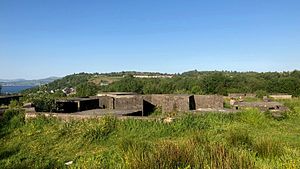
During World War II, a large part of the golf course was used for a special anti-aircraft rocket battery. This battery, known as Site Cz4 Z Battery, helped defend the area against air raids. It had four rocket launchers and radar units. After the war, the golf course was put back together and redesigned.
Greenock was also a big base for the Free French Naval Forces during the war. After the war ended, they designed and built the Free French Memorial right next to Lyle Road. This memorial was paid for by the French soldiers and sailors themselves. It was officially opened on January 15, 1946, in a special ceremony.
In 1977, a special beacon was built at the Lyle Hill viewpoint to celebrate the Queen Elizabeth's Silver Jubilee. This beacon is lit on important occasions, like the Queen's 90th birthday in 2016.
Every year, on Remembrance Sunday, ceremonies are held at the Free French Memorial to remember those who fought in wars. In 2018, for the 100th anniversary of the end of World War I, a bagpiper played at dawn, and later that evening, the Lyle Hill beacon was lit, along with many other beacons across the United Kingdom.
Amazing Views from Lyle Hill
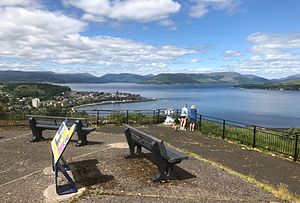
The viewpoints on Lyle Hill offer incredible panoramic views across the Clyde. You can see Gourock and the Tail of the Bank, which is where the River Clyde widens out into the Firth of Clyde.
You'll also see the Cowal hills, with the town of Dunoon below them, and the Holy Loch. On a clear day, you might even see past the Erskine Bridge to Glasgow in the east, and the Isle of Arran to the southwest.
Right below the hill to the north is Greenock's Battery Park, which has flat playing fields. To the west is Gourock's Cardwell Bay. The area is also home to Fort Matilda, a name now given to the local railway station and the playing pitch of the local rugby team, the Greenock Wanderers.
The main viewpoint has a beacon that was built for the Silver Jubilee of Queen Elizabeth in 1977. It's lit up for special events. On the other side of the road, you can climb steps and a path to Craigs Top, the very highest point of the hill. The north and west sides of the hill have steep cliffs, called craigs, which were formed by ancient glaciers.
The Free French Memorial, Greenock stands on the western side of the hill. It's shaped like the Cross of Lorraine, which was the symbol of the Free French forces. The memorial has plaques that remember French ships and submarines that were lost during World War II, like the corvettes Alyssa and Mimosa, and the submarine Surcouf. It also reminds people of the Maillé Brézé, which exploded nearby.


